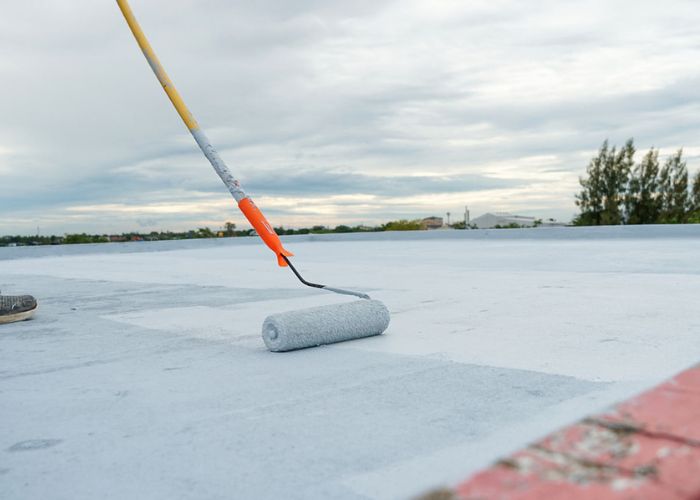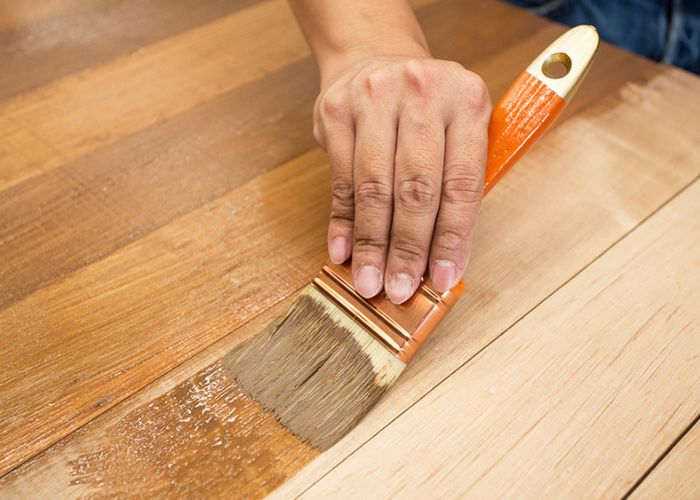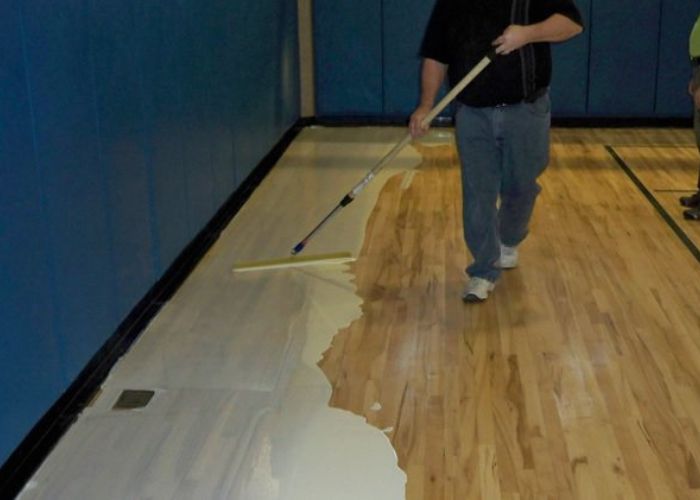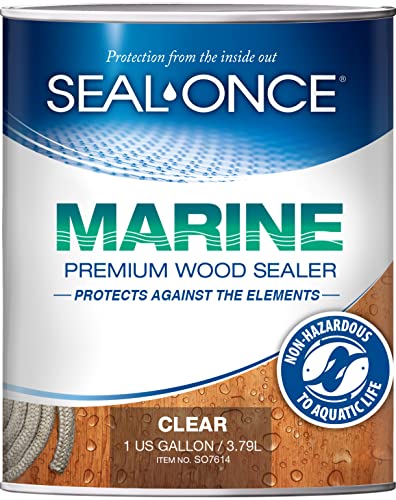Polyurethane is a household name across the woodworking community due to its numerous benefits. But is polyurethane waterproof, or does it need to be used alongside other waterproofing methods to protect the wood from water damage?
Polyurethane is a varnish and synthetic resin popular for finishing wooden floors, furniture, cabinets, and other wooden items.
Its transparent color and film-forming quality make it desirable, especially for those who prefer to protect wood without concealing its natural color.
But does polyurethane waterproof wood?
Let’s dive right in to find out.
Is Polyurethane Waterproof?
No, polyurethane is not waterproof; it is water-resistant. This synthetic resin dries on the wood surface to form a hard, protective film resistant to scratches and discoloration from fungi and mildew. Polyurethane also makes it more difficult for water to penetrate the wood.
Does Polyurethane make Wood Waterproof?

A polyurethane topcoat will repel water, preventing it from seeping into the wood, but the film isn’t 100-percent watertight. It is discontinuous, meaning that minor holes remain on the layer of polyurethane that can allow some water through.
Since polyurethane coats are pretty thin, a single layer is insufficient. Applying more layers of the product (at least three) ensures better protection and more resistance to water and other liquids.
The protection is also greater and more durable, with more polyurethane layers on the surface of the wood. It forms a plastic-like layer that is more resistant to weakening as the wood expands and contracts.
And, will polyurethane keep wood from cracking? Read to find out.
Does Polyurethane Waterproof Wood?
Polyurethane doesn’t make wood waterproof, even if you cover every wood surface with multiple coats. Instead, it creates a hard-wearing coat on the wood surface that repels water but doesn’t completely seal it.
When you apply a fresh coat of polyurethane on wood, it will seal it and make it watertight for some time. However, the wood’s constant expansion and contraction naturally create multiple weak points on the polyurethane film, allowing some water through.
The product will continue to repel water without recoating for a long time. However, it will give enough water pooling on the coated surface to penetrate the wood.
So you can always care for polyurethane-coated surfaces by wiping spills off them as soon as they occur.
Read also: Can you tint water-based polyurethane?
Does Polyurethane Protect the Wood from Water?

Yes, polyurethane forms a hard-wearing layer on the wood surface that repels water and moisture. While the protective film has microscopic pores on its structure that can let some water through, it goes a long way in repelling that water and protecting the wood.
A single layer of poly is usually less resilient against water, with small pores on its structure. Every additional layer you apply onto the surface makes the coat more continuous, reducing its porosity.
The more layers of polyurethane you apply to wood, the more protection it offers. About three layers of polyurethane are usually recommended for the best protection.
The product doesn’t penetrate the wood like stain and other wood finishes. Instead, it forms a transparent coat on the wood surface. The more layers you apply, the thicker the coat and the better the protection.
Despite the limitation of polyurethane, don’t rule it out. The product offers different kinds of protection that can benefit your hardwood floors and furniture.
For instance, waterproof polyurethane varnish protects countertops, ceilings and wood walls from molds and fungi. It’s also resistant to light and heat, so it will do an excellent job protecting wood from fading and discoloration.
Interesting read: Best polyurethane for countertops.
How Do You Make Wood Waterproof?
Wood requires some form of protection from water and moisture damage. Exposure to damp conditions or humid environments can cause warping, swelling, or rotting.
Moisture and accumulated dust from the atmosphere can also provide a foothold for molds and fungi. Such infestation can lead to discoloration and damage.
Most waterproofing products also offer protection from the sun’s ultraviolet rays. This protection goes a long way in keeping wood from fading and preserving its natural beauty.
For these reasons, knowing how to make wood waterproof is a crucial way to protect your wooden furniture, floors, railings, deck, and other valuable items. Waterproofing can you’re your wood last much longer regardless of the environmental conditions around it.
While polyurethane may not provide the ultimate protection for wood, multiple waterproofing methods are available to choose from.
Read along to find out how to waterproof wood for indoor and outdoor use.
Method 1: Use a sealant to make wood waterproof
- Item Weight: 9.65 lb
- Country of Origin: China
- Brand name: Thompson's Water Seal
You can choose from a wide range of products formulated and labeled as sealants for waterproofing wood. Some tried, and true options include varnish, lacquer, and polyurethane sealants.
Sealants are wood finishing products with excellent waterproofing properties. To make the most of each, ensure it’s designed for the application you are buying it for. For example, you don’t want to buy an indoor wood sealer for an outdoor application and vice versa.
Outdoor sealants usually have UV protective features in their formula. They are formulated to withstand the harsh weather elements outside. In contrast, indoor sealants are designed to work best indoors and may not be good for outdoor applications.
How to use a sealant to waterproof wood
Step 1: Select a sheltered workspace away from direct sunlight. Most sealants evaporate quickly, so exposing them to direct sunlight and high temperatures may accelerate the drying process unfavorably.
Consider applying the finish within a room temperature environment with good ventilation to ensure proper drying time and setting.
Step 2: Sand and clean the wood surface to improve adhesion and ensure a clean finish. You don’t want to seal a surface with debris as that will lock the debris in with the wood, affecting the quality of the finish.
So it is recommended to smoothen the surface through sanding and cleaning it with a tack cloth or damp rag. Next, let the surface dry before applying the sealant to it.
Step 3: Apply the sealant using the best brush for poly, paint roller, or sprayer. If the product is in a spray can, your work is cut out for you. All you need to do is pop the cover and spray it on the wood using the spray can containing it.
Don’t stir or shake clear-coating sealants before applying them. The action can create air bubbles that remain on the finished surface even after drying.
Step 4: Allow the sealant to dry completely before applying another coat. Most sealants require about three coats to provide adequate surface protection. Before recoating, you must allow each coat to dry for the recommended drying time (on the product label).
Once each coat has dried completely, you may need to scuff sand it before applying a subsequent coat for the best results. The sanding helps scuff up the surface and improves the adhesion of the succeeding coat.
Method 2: Apply wood oil to make wood waterproof
- Easy to Use - Tung oil is a natural oil recognized by craftsmen to offer the ultimate hand-rubbed finish for all fine woods; just wipe on and allow the oil to cure at room temperature
- Permeates - Unlike other finishes that form a film on the wood’s surface, tung oil penetrates deep into the wood fibers, cures to a flexible non-oily solid, and becomes part of the wood itself
- Protects - Resistant to moisture, alcohol, oil, and everyday wear for lasting beauty and protection; lasts many times longer than mineral oil and wax based products
Wood oils are an excellent way to create a warm, protective finish on the wood. Linseed oil, Tung oil, and Walnut oil are some of the most popular options to choose from. If you’re considering your options, you may want to read our article on polyurethane vs tung oil to determine what suits your project.
These oils are also the main ingredients for various wiping oil finishes for protecting and waterproofing wood. In addition, you can use the individual oils of their blends for your purposes.
Linseed oil is the most popular wood oil for waterproofing purposes. You may also know it as flax oil or flaxseed oil derived from dry, ripened seeds of the flax plant.
Boiled linseed oil is ideal for waterproofing outdoor wood furniture. On the other hand, raw linseed oil is suitable for several applications and should be the oil of choice for any DIY woodwork.
Tung Oil may be an excellent choice if you are working on a small wood project since it’s expensive. Find out whether tung oil and polyurethane go together.
You could also opt for Walnut oil, which resembles olive oil, except it is rarely used for commercial purposes since it can trigger an allergic reaction.
Danish oil is another popular oil for waterproofing wood that comprises a mixture of polymerized linseed oil or Tung oil and other ingredients, often including mineral spirits.
Its formula varies from one manufacturer to another because there’s no standard formulation for the oil.
Unlike most oils, Danish oil dries hard and cures fast to provide a hard-wearing finish resistant to water. If you use Danish oil over water-based poly, ensure you apply three or more coats to create a stronger, more protective layer.
Alternatively, you can create your durable blend by mixing linseed oil with apple cider vinegar and turpentine. Adding these special ingredients makes the finish fast-drying and non-sticky.
Recommended read: Danish oil for pine
Whether you choose to create your custom finish or purchase pre-blended linseed oil and Tung oil products, follow these steps to finish your wood.
Step 1: Sand the wood surface and clean it to remove the dust and debris. You can use a tack cloth or damp rag to clean and prep the surface for oiling.
Step 2: Stir the oil blend and apply it on the wood surface with a natural bristle paintbrush to form the first coat. Let it sit for several minutes to penetrate the wood, and reapply to any spots that look prematurely dry. The objective is to create a nice, even coverage.
Once the wood has absorbed the oil, use a lint-free cloth to wipe away any excess oil. After that, leave the wood to cure for at least 24 hours.
Step 3: Scuff sand the dry surface with fine 400-grit sandpaper and apply another coat.
Step 4: Repeat the process with as many as three or more additional coats of the oil, letting each coat dry completely before sanding and reapplying the oil.
Method 3: Apply a stain-sealant combo to finish and waterproof wood simultaneously
- MARINE SEALANT: Our liquid formula creates a UV-stable coating for protection against the elements, saltwater spray, and water damage. Marine is a great protector for outdoor furniture, thermally modified wood, and boat docks. Marine is safe for use over open water and is non-hazardous to aquatic life.
- DECK STAIN: It's water-based, ultra-low VOC, great for enhancing the extended life of your flooring, siding, and porch. The paint forms a water-resistant shield around wood fibers at the cellular level to help preserve the natural color.
- WATERPROOF WOOD SEALER: The wood used on boat docks, decks, and retaining walls near rivers, lakes, oceans, and ponds is subjected to constant moisture. We crafted a sealer, remove stain, and finish all in one, specifically for these installations.
If you waterproof a wooden deck, stain-sealant combos such as BEHR Premium waterproofing stain and sealer can offer the best results.
They are ideal for large waterproofing projects and will allow you to finish them within the same day. For instance, Thompson’s WaterSeal waterproofing stain doesn’t require the wood to be dry completely.
So you can power wash the deck and finish it within a matter of hours. These special products add color to the wood and resilience against water.
They contain color pigments that go a long way in protecting the wood surface against the sun’s damaging rays. Their formula also includes water-oil-or alkyd-based binders.
As is the norm, always clean the wood surface and sand it with an orbital sander before applying the finish. Additionally, make sure you follow each specific product’s application instructions to get the best results.
Finally, it’s recommended that you reapply these products every year or two depending on the product formula to keep the wood protected and waterproof.
See also: How to waterproof pine wood for outdoor use
Is Oil-based Polyurethane Waterproof?
Neither oil-based poly nor water-borne poly is waterproof. Instead, they are water-resistant and will create a protective coat on the wood surface, resilient to water and moisture damage. Still, oil-based poly is superior to various mid and low-grade water-based polyurethanes in the market.
Read also: How to apply wipe-on poly to your wood.
Are Shinier Floors more Water-resistant?
Shinier finishes floors are not as resistant to water as matte or satin finishes. All the different sheen levels – high gloss, semi-gloss, satin, and matte – rank equally in durability.
Nonetheless, less shiny finishes hide imperfections better and generally look better for longer than their glossier cousins. The shinier the floor, the more light it reflects, highlighting imperfections such as scratches and dents more readily.
Interesting read: Satin vs gloss polyurethane.
FAQs
Is Water-based Polyurethane Waterproof?
No, water-based polyurethane is not waterproof, but it is water-resistant. Applying multiple layers of water-based poly on wood makes it durable and more resilient against water, molds, and fungi. The protective coat of water-based poly is also resistant to abrasion.
What Happens to Polyurethane over Time?
Over time, wood’s constant expansion and contraction create more weak points and microscopic pores on the polyurethane layer. This means the poly will be less resistant to water and water over time, allowing for more water to penetrate and reach the wood.
Is Polyurethane Foam Waterproof?
No. Polyurethane foam has a porous, cellular structure that is not waterproof. Various factors make some polyurethanes more absorbent than others. In this case, the porous, cellular structure is one reason why the polyurethane foam is more absorbent than other polyurethanes.
Is Minwax Polyurethane waterproof?
Minwax fast-drying polyurethane is not waterproof, but it offers more resistance to water than most polyurethanes. In addition, it is a clear, oil-based finish for wood that offers more long-lasting protection than many other clear coats on finished or unfinished wood.
Is urethane waterproof?
Urethane wood finish protects wood surfaces from scratches and helps resist water damage, but it is not waterproof. You can make polyurethane protect the wood from water absorption better and for longer by applying multiple coats.
Will polyurethane prevent water rings?
Despite its incredible ability to repel water, polyurethane is still susceptible to water ring damage like most finishes. However, consider applying more layers of polyurethane finish to make it harder for condensation to get into the coat. The more the layers of poly, the better it makes wood water-resistant.
Does polyurethane protect wood from water?
Yes, polyurethane provides a protective layer on hardwood, which will help to protect the wood from moisture and water damage. To ensure that polyurethane is effective in protecting the wood, it is important to make sure that the wood is clean and free of any dirt or debris before application.
Is polyurethane water-resistant?
Yes, polyurethane is water-resistant. You can brush it or spray it after sanding and cleaning your surface, plus, give it time to dry. Preparing your surface makes polyurethane adhere well. However, it is important to differentiate polyurethane is not waterproof and does not protect against water.
Is varnish waterproof?
Varnish is indeed waterproof and is therefore often used as a sealant for wood. Though it can be applied to other surfaces, varnish is most commonly associated with woodwork, as it can help protect against water damage. There are many different types of varnish on the market, so it’s important to choose the right one for your needs
Recommended reads:
How to tell if polyurethane is bad.
Final thoughts on does polyurethane waterproof wood
So, is polyurethane waterproof? Unfortunately, no, but it is one of the best and most long-lasting finishes available for wood. It can also repel water well while protecting the wood surface from scratches, molds, and fungi.
We hope that this tutorial helped answer your question regarding polyurethane and its use in waterproofing wood. Please leave any thoughts or comments in the comments section.
What next? Read our guide on removing water-based polyurethane from wood.




